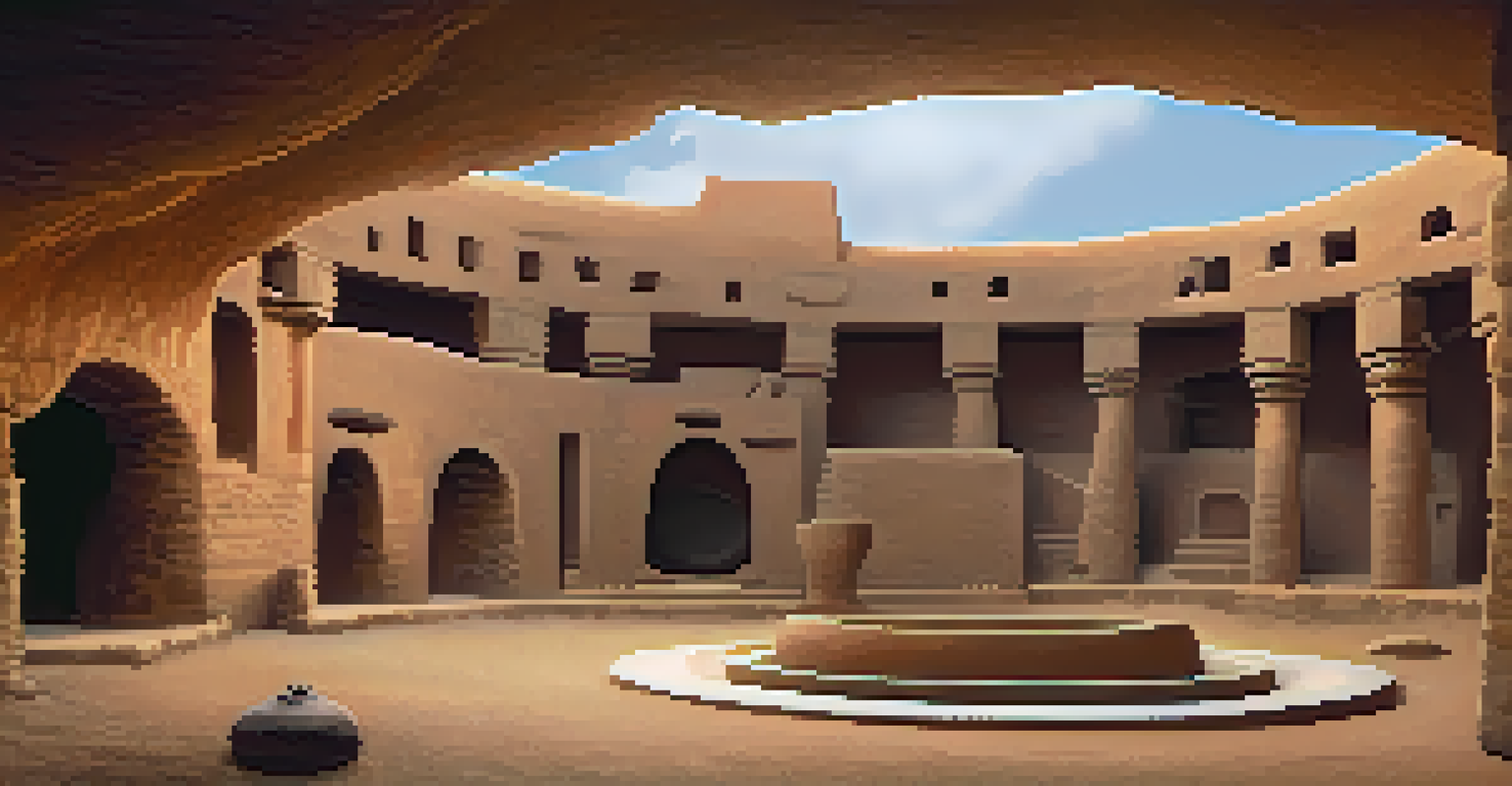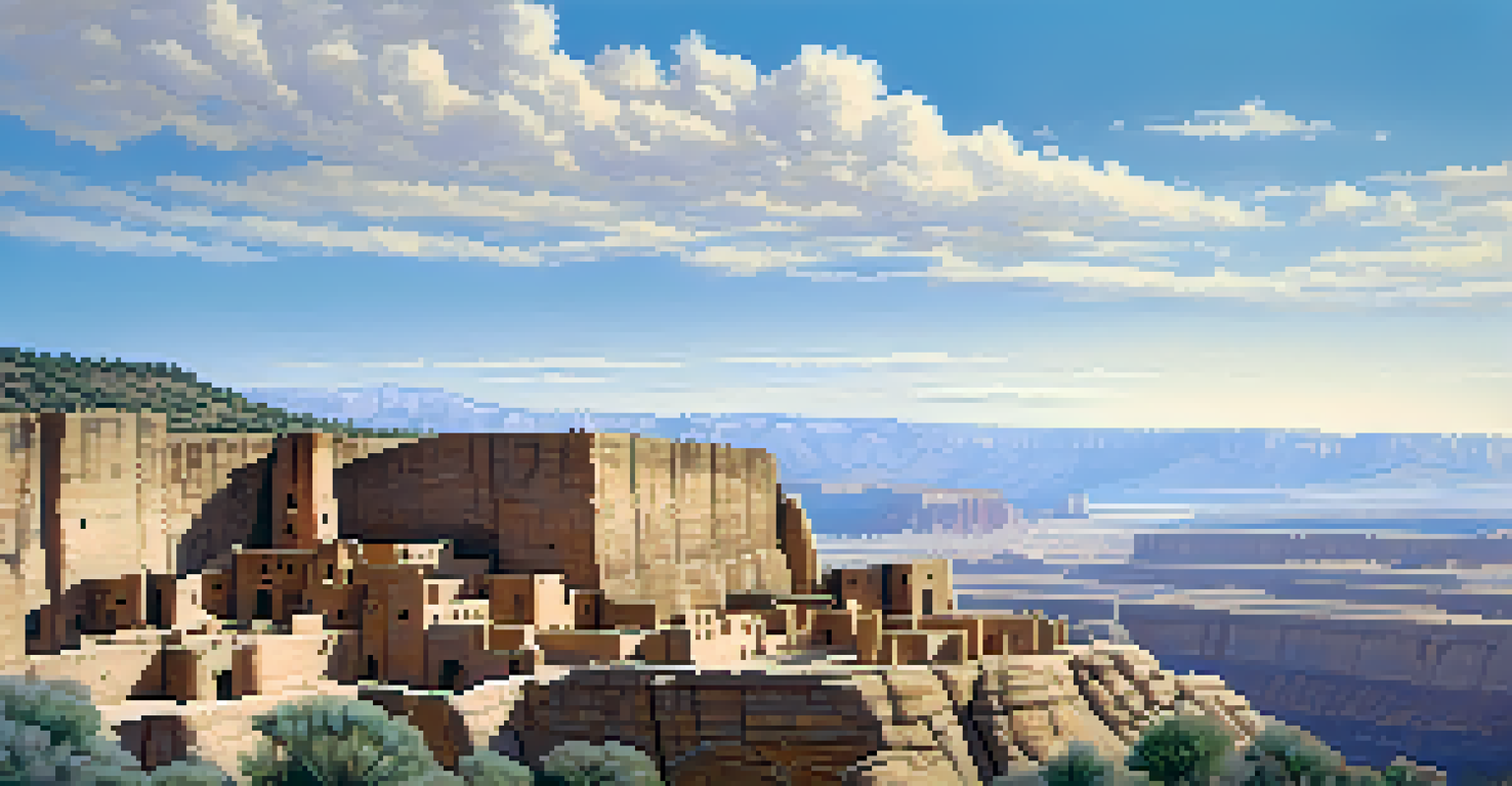Understanding the History of the Cliff Dwellings at Cliff Palace

Introduction to Cliff Palace and Its Significance
Cliff Palace, nestled in the stunning Mesa Verde National Park, is one of the most famous cliff dwellings in North America. This remarkable site showcases the ingenuity and architectural skills of the Ancestral Puebloans, who inhabited the area over 700 years ago. As a UNESCO World Heritage Site, Cliff Palace not only attracts tourists but also scholars and history enthusiasts eager to learn more about the lives of its ancient inhabitants.
We do not inherit the earth from our ancestors; we borrow it from our children.
The dwellings were built into the cliffs, providing both protection from the elements and a strategic vantage point against potential threats. This unique architectural style demonstrates how the Ancestral Puebloans adapted to their environment, utilizing local materials like sandstone and timber. The design reflects a deep understanding of the natural landscape, emphasizing their connection to the land.
Today, Cliff Palace serves as a testament to the resilience and resourcefulness of its builders. By studying this site, we gain valuable insights into the social, cultural, and technological advancements of the Ancestral Puebloans. In the following sections, we will explore the history, construction, and significance of Cliff Palace in greater detail.
The Origins of the Ancestral Puebloans
The story of Cliff Palace begins with the Ancestral Puebloans, a group of indigenous peoples who thrived in the Four Corners region of the United States. These early inhabitants, originally nomadic hunter-gatherers, transitioned to a more settled lifestyle around 600 AD, primarily due to the development of agriculture. This shift allowed them to cultivate crops like corn, beans, and squash, which formed the backbone of their diet.

As their society evolved, the Ancestral Puebloans began constructing more permanent dwellings, eventually leading to the creation of complex cliff dwellings such as Cliff Palace. This architectural innovation was not just for shelter; it also played a critical role in their spiritual and social lives. The cliffs provided a sense of safety and community, fostering a deep connection to their environment.
Cliff Palace: An Architectural Marvel
Cliff Palace showcases the advanced engineering and architectural skills of the Ancestral Puebloans, who built these intricate dwellings into the cliffs over 700 years ago.
Understanding the origins of the Ancestral Puebloans helps us appreciate the significance of Cliff Palace within their cultural narrative. Their journey from nomadic lifestyle to sophisticated society laid the groundwork for the impressive structures we see today. In this section, we see how their adaptation and resilience shaped their way of life.
Construction Techniques of Cliff Palace
The construction of Cliff Palace is nothing short of a marvel, showcasing advanced engineering techniques for its time. The Ancestral Puebloans utilized locally sourced materials such as sandstone, adobe mortar, and wooden beams to create their homes. This not only ensured that the dwellings blended harmoniously with the surrounding landscape but also provided structural integrity against natural elements.
The land is the source of life, and those who dwell upon it are its guardians.
One of the most impressive aspects of Cliff Palace is its multi-story design, which includes over 150 individual rooms, kivas, and storage areas. Kivas, circular underground rooms, played a vital role in their spiritual practices and communal gatherings. The careful planning and execution of these structures demonstrate a deep knowledge of architecture and community needs.
The construction process itself was a community effort, involving the skills and labor of many individuals. This collaboration reflects the social dynamics of the Ancestral Puebloans, emphasizing the importance of community bonds. The techniques used in building Cliff Palace not only highlight their architectural prowess but also their ability to work together toward a common goal.
The Daily Life of Cliff Palace Inhabitants
Life in Cliff Palace was rich and varied, shaped by both the environment and the community's cultural practices. The inhabitants relied heavily on agriculture, with farming being a central aspect of their daily routine. Families worked together in the fields, tending to their crops and gathering resources, which fostered a strong sense of community and cooperation.
Beyond farming, the daily life of the Cliff Palace residents included various crafts and trades. They were skilled in pottery, weaving, and tool-making, which not only provided for their needs but also served as a means of cultural expression. These activities were often intertwined with spiritual beliefs, further reinforcing their connection to the land and their community.
Cultural Hub of Ancestral Puebloans
The site served as both a physical dwelling and a center for spiritual and communal rituals, reflecting the deep cultural significance the Ancestral Puebloans placed on their environment.
Understanding the daily life of the Cliff Palace inhabitants gives us a glimpse into their values and priorities. Their focus on community, sustainability, and craftsmanship reflected a deep respect for their environment and each other. This perspective enriches our appreciation for the lives they led in this remarkable cliff dwelling.
Cultural and Spiritual Significance of Cliff Palace
Cliff Palace was not just a physical dwelling; it held profound cultural and spiritual significance for the Ancestral Puebloans. The site is believed to have been a center for rituals and ceremonies, connecting the inhabitants to their ancestral heritage and the natural world around them. The strategic positioning of the dwellings allowed them to observe celestial events, which likely played a role in their spiritual practices.
Kivas, integral to the community's spiritual life, served as spaces for rituals, storytelling, and decision-making. These sacred spaces were often decorated with intricate symbols and designs, reflecting the beliefs and values of the people. The communal aspect of these rituals fostered unity and strengthened social bonds within the group.
Today, the cultural and spiritual significance of Cliff Palace continues to resonate with indigenous peoples and historians alike. The site serves as a reminder of the rich traditions and beliefs that shaped the Ancestral Puebloans' way of life. By exploring this dimension, we can better understand the legacy of Cliff Palace and its enduring impact on contemporary cultures.
The Decline and Abandonment of Cliff Palace
Despite its splendor, Cliff Palace faced challenges that led to its eventual decline and abandonment. By the late 12th century, various factors, including prolonged drought, resource depletion, and social strife, began to take a toll on the community. These environmental and social pressures made it increasingly difficult for the inhabitants to sustain their way of life.
As conditions worsened, many families chose to leave Cliff Palace in search of more favorable living situations. The once-thriving community gradually dwindled, leading to the eventual abandonment of the dwellings. This exodus marked a significant turning point in the history of the Ancestral Puebloans, as they adapted to new environments and lifestyles.
Challenges Leading to Abandonment
By the late 12th century, environmental factors and social strife contributed to the decline and eventual abandonment of Cliff Palace, marking a pivotal moment in the history of the Ancestral Puebloans.
While the abandonment of Cliff Palace is a somber chapter in its history, it also reflects the resilience of the Ancestral Puebloans. Their ability to adapt and survive in changing conditions is a testament to their strength and ingenuity. Understanding this decline helps us appreciate the complexities of their history and the factors that influenced their decisions.
Preservation and Modern-Day Significance
Today, Cliff Palace stands as a remarkable symbol of cultural heritage and historical significance. Preservation efforts have been undertaken to protect this ancient site from the ravages of time and environmental factors. The National Park Service plays a crucial role in maintaining the integrity of Cliff Palace, ensuring that future generations can appreciate its beauty and history.
Visitors to Cliff Palace are encouraged to engage with the site respectfully, learning about the stories and traditions of the Ancestral Puebloans. Guided tours and educational programs help foster a deeper understanding of the cultural significance of the dwellings. This connection to the past enriches the visitor experience and promotes appreciation for indigenous cultures.

As we reflect on the importance of Cliff Palace, it's essential to recognize its role in the broader narrative of human history. The site serves as a reminder of the ingenuity and resilience of ancient peoples, inviting us to consider our own relationship with the environment and cultural heritage. By valuing and preserving such sites, we honor the legacy of those who came before us.